

What is Newton's Second Law? If we know all of the forces that are acting on an object, we can know how the object will move. This is how NASA scientists are able to predict the motion of planets, comets, and other astronomical bodies.

Closer to home, here on Earth, we can also predict the motion of everyday objects if we know all of the forces acting on the objects. For example, we can predict the motion of a shopping cart someone is pushing through a supermarket or the motion of a ball rolling down a hill.

We can figure out the motion of objects using the equations of Newton's Second Law. Newton's Second law is sometimes expressed as: Force equals mass times acceleration (or F = ma).
This is a much simpler way of saying what Newton's second Law really means:
The acceleration of an object in a given direction is equal to the "net" sum of all
forces that are acting on the object in that direction divided by the mass of the object.

Question for you: Does an object's acceleration cause forces to act on the object ((OR)) do forces
acting on the object cause an object's acceleration?
(Think about this for a few seconds before going to the next page...)
If you said the forces acting on an object determine the object's acceleration, then you were right. (Good going!)
Because an object's acceleration is caused by forces acting on it, it actually makes much more sense to write Newton's second law as:

So, we can figure out the acceleration of an object in a direction if we know (a) its mass and (b) the sum of all of the forces that are acting on the object in that direction.
This may be a little hard to understand (it's a bit complicated!). Let's see what this means. We will give examples of applying Newton's Second Law, starting with the simplest scenarios...
Acceleration when no forces act on object. Here on Earth, because gravitational forces affect all objects, we don't come across cases where no forces act on objects. We need to go deep into outer space for that...
Example. An space rock is in outer space. No forces are acting on the space rock. What is its acceleration?

This means that the sum of all forces acting on the space rock (in any direction) is equal to 0 N.
We will apply Newton's Second Law:
And because there are no forces acting in any direction, the acceleration of the space rock is zero in all directions. That is, the space rock does not accelerate in any direction.
Example 1 (One force): Two astronauts are in a space shuttle in outer space, where there is no gravity. The astronauts are hungry, so one gets a candy bar from storage and gently pushes it to the other astronaut with a force of 0.1 N (one-tenth of a Newton).
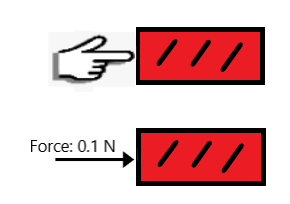
This means that the sum of all forces acting the object (candy bar) would be 0.1 N.
The candy bar has a mass of 0.1 kg. What is the acceleration of the candy bar while the astronaut is pushing it?
We will apply Newton's Second Law here:
It's important to understand that when the astronaut stops pushing on the candy bar, its acceleration becomes zero. This is because now there are no forces acting on the candy bar.
Example 2 (One force): A 10 kg block is sitting on a flat horizontal ice surface. As shown below, someone pushes horizontally on the block in the +x-direction (to the right) with a force of 2 N.
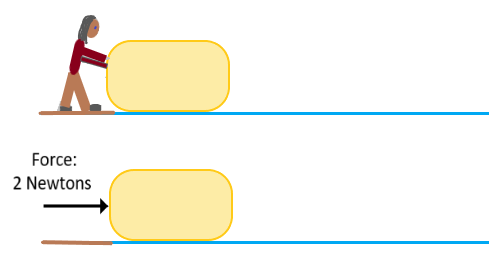
What is the horizontal acceleration of the block while it is being pushed? (Assume that there is no friction between the block and ice surface.)
To answer this question, we will again apply Newton's second law: The acceleration of an object in the horizontal direction is equal to the sum of all forces ("net" force) acting on the object in the horizontal direction divided by the mass of the object (or a = F/ m).
Only one force acts on the block in the horizontal direction: the +2 N pushing force.
(But right when the push ends, the acceleration of the block will be zero.)
Acceleration when more than one force acts on an object. Things get a bit more complicated when there is more than one force acting on an object in a particular direction.
Again, Newton's Second Law says that the acceleration of an object in a particular direction is equal to the sum of all forces acting on the object (the "net force") in that direction divided by the acceleration of the object in that direction.
When there is more than one force acting on an object, we need to calculate the "net" force.
Calculating the Net force. The “net” force in a given direction is the sum of all forces acting in that direction minus the sum of all forces acting in the opposite direction.
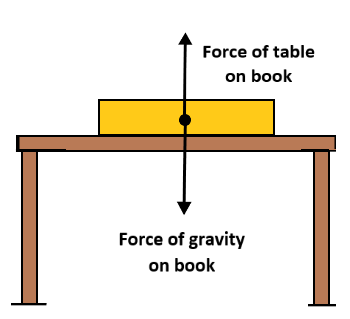
We will calculate the Net force in the vertical direction:
We now know the net force force acting on the book in the vertical direction (0 N). We also know the mass of the book (1 kg).
So, the book's acceleration is equal to zero. It does not change its motion since the forces acting on it are balanced.
Example 2 (Multiple forces). In a game of tug-of-war, there are two forces acting on the rope (with a red flag in the middle) in the horizontal direction. (See picture below.) If the two teams pull equally hard on the rope but in the opposite directions (one team pulls horizontally to the right and the other team pulls horizontally to the left), the rope will not move; neither will the people pulling.
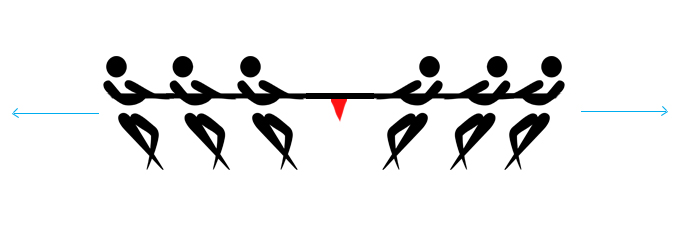
Now, let's say that someone on the team on the right lost their grip on the rope for just a moment. As a result, the rope starts moving (or accelerates) to the left. After the recovery and the person regains their grip, both teams are again pulling in opposite directions with the same force. Because the net force acting on the rope is once again zero, the rope does not accelerate: the rope does not speed up or slow down. Instead, it keeps moving to the left at that same speed. Soon, the team on the left wins the contest!
In these examples, the net force acting on the object in the given direction was zero. So, the acceleration of the object was also zero in that direction. (Remember: constant speed — without changing direction — is also zero acceleration!)
The mom is pulled in two opposite directions by her two children. The older child pulls her to the right with a force of 50 Newtons. The younger child pulls her to the left with a force of 20 Newtons.
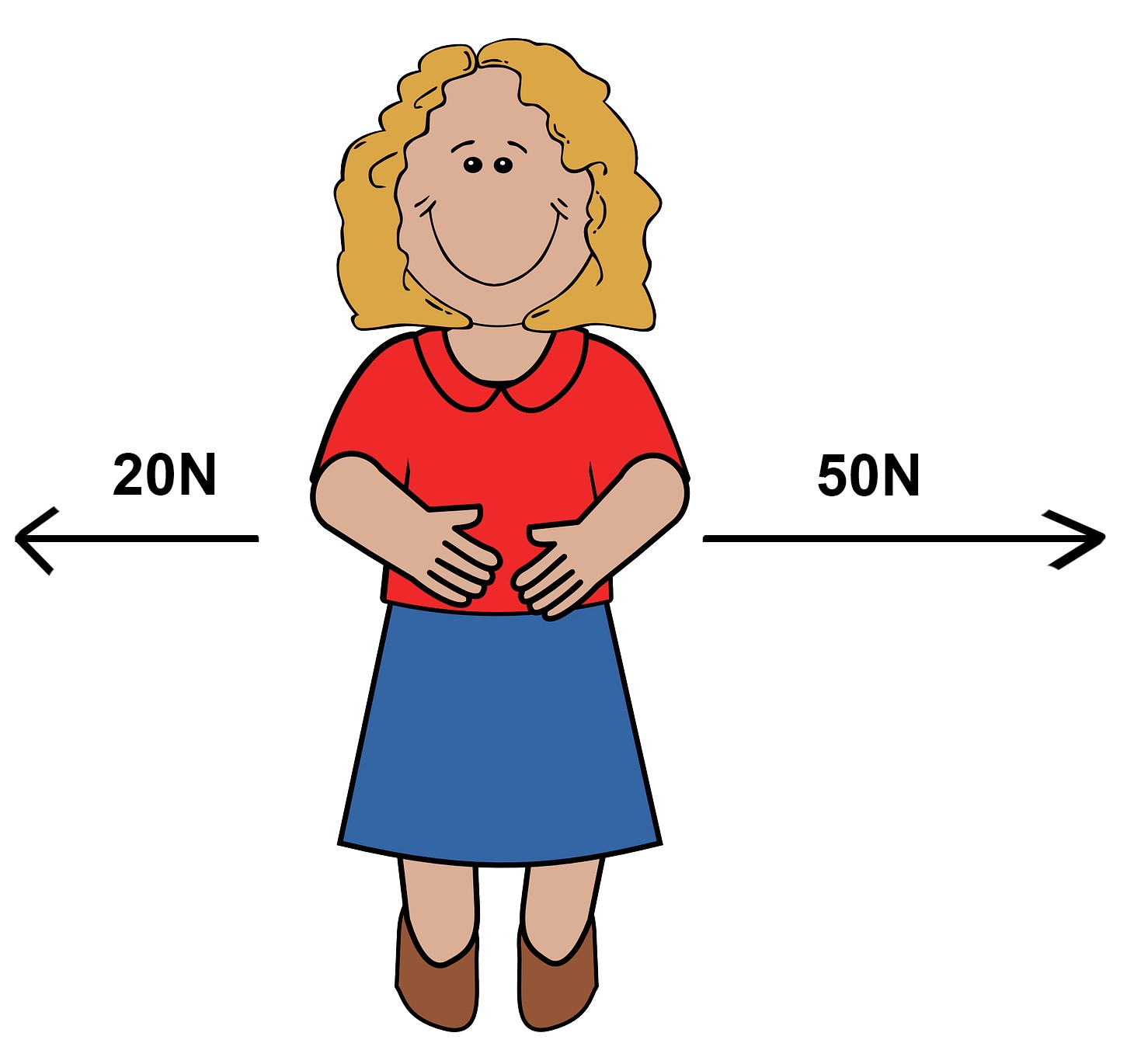
Example 4 (Multiple forces): Now, let's say we have a 10 kg object, which is acted on by four forces as shown below. What is the acceleration of the object?

We can find the acceleration of the body by (you guessed it!) applying Newton's Second Law: a = Fnet / m
Summary: The Net force acting on an object determines its acceleration. If the Net force acting on an object in a given direction is NOT equal to zero, the object will accelerate in the direction of the net force.
For example:
How fast the object accelerates depends on the magnitude (value or amount) of the net force. As the magnitude of net force increases, the magnitude of the acceleration will also increase.
Mass and Acceleration.
The mass of the object also affects how much the object accelerates when a net force acts on the object.
As you probably think, the more mass an object has, the less the object will accelerate when the same net force acts on it.
And the less mass an object has, the more it will accelerate when that same net force acts on the object.
This relationship between mass and acceleration is shown below.
This relationship between mass and acceleration for a constant force (shown in the graph above) can be written as:
Acceleration (of object) ∝ 1 / mass (of object)
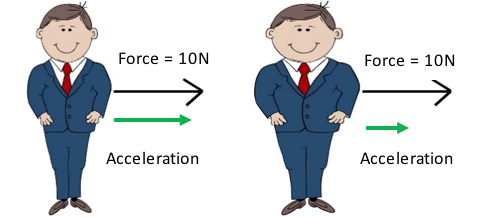
Relationship between Net force, Mass, and Acceleration.
In summary, the acceleration of an object is directly proportional to the net force acting on the object and inversely proportional to its mass. These relationships are summarized in Newton's Second Law: The acceleration of an object [in a given direction] is equal to the net force acting on the object in that direction divided by the mass of the object:
